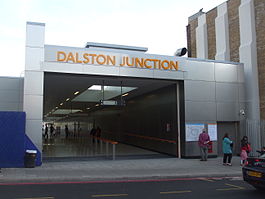
Back محطة دالستون چونكتيون ARZ Bahnhof Dalston Junction German Dalston Junctionin rautatieasema Finnish Gare de Dalston Junction French Dalston Junction állomás Hungarian Stazione di Dalston Junction Italian Station Dalston Junction Dutch Dalston Junction stasjon NB Dalston Junction (stacja kolejowa) Polish Долстон-джанкшен (станція) Ukrainian
| Dalston Junction | |
|---|---|
 North entrance on day of re-opening in April 2010 | |
| Location | Dalston |
| Local authority | London Borough of Hackney |
| Managed by | London Overground |
| Owner | Transport for London |
| Station code(s) | DLJ |
| Number of platforms | 4 |
| Accessible | Yes[1] |
| Fare zone | 2 |
| OSI | Dalston Kingsland |
| National Rail annual entry and exit | |
| 2019–20 | |
| 2020–21 | |
| 2021–22 | |
| 2022–23 | |
| 2023–24 | |
| – interchange | |
| Railway companies | |
| Original company | North London Railway |
| Pre-grouping | London and North Western Railway |
| Post-grouping | LMS |
| Key dates | |
| 1 November 1865 | Opened |
| 30 June 1986 | Closed |
| 27 April 2010 | Reopened (as temporary ELL terminus) |
| 28 February 2011 | Fully reopened with through service to Highbury & Islington |
| Other information | |
| External links | |
| Coordinates | 51°32′43″N 0°04′29″W / 51.54539°N 0.07474°W |
Dalston Junction is a station on the Windrush line of the London Overground, located in Dalston, London. Situated in Travelcard Zone 2,[4] the station is located in a short section of cut and cover tunnel north of the Kingsland Viaduct, at the crossroads of Dalston Lane, Kingsland Road and Balls Pond Road.
There is an official out-of-station interchange with Dalston Kingsland station on the Mildmay line of the Overground, located 250 metres (820 ft) walk away. Dalston Junction is an inter-modal rail and bus transport interchange, with numerous bus routes also serving the station.
- ^ "Step free Tube Guide" (PDF). Transport for London. April 2021. Archived (PDF) from the original on 15 May 2021.
- ^ "Out-of-Station Interchanges" (Microsoft Excel). Transport for London. 2 January 2016. Retrieved 28 August 2016.
- ^ a b c d e f "Estimates of station usage". Rail statistics. Office of Rail Regulation. Please note: Some methodology may vary year on year.
- ^ "Tube map" (PDF). Tfl.gov.uk. May 2022. Retrieved 2 June 2022.
